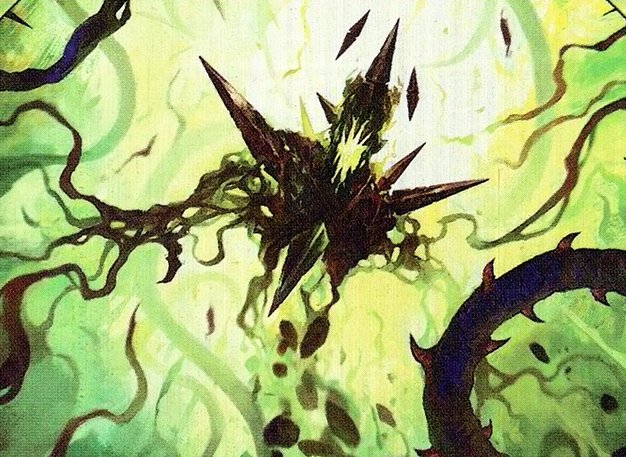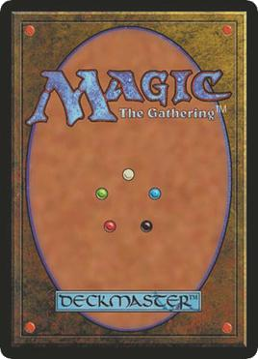 Art by Dominik Mayer
Art by Dominik MayerThis is a cube based on the very fun interaction between "bounce-lands" and the modal double-faced cards from Zendikar Rising and Modern Horizons III. The MDFCs can be played on early turns as lands, but later be returned to hand with the bouncelands, or other cards in the cube, and cast as more powerful spells. This cube includes two full cycles of the Ravnica Guild bounce-lands from the original Ravnica block, almost all of the 'MDFCs" from Zendikar Rising, and all of the monocolored MDFCs from Modern Horizons III.
The power level is aimed to be closer to a Modern Masters set draft rather than that of a standard set or trying to max-out power level of all the cards. There is no Swords to plowshares, Counterspell, or Lightning Bolt in this cube. While these are all great and iconic cards that I love, they are too powerful for this environment. Instead, we have cards like Stroke of Midnight, Neutralize, and Lightning Strike. These cards better match up with the power level of the surrounding cards. The threats in this cube are, on average, much less powerful than what these cards typically used to interact with and having more expensive answers to those threats promotes games that are more focused on the battlefield instead of the hand. However, this doesn't mean that premium removal is only found at four mana and above, because I find those cards lead to massive board stalls that drag games and are also cards that typically don't excite players.
Given this design philosophy of lower power, it may seem odd to include both the full cycle of fetchlands and the full cycle of shocklands, both of which are known for being staples of high-powered eternal formats. My logic here is that these cards will be in the packs, and therefore must be personally picked in the draft by players, over potentially more powerful non-land cards. My goal with these land choices was to enable players more easily cast their spells so they don't have to worry about getting screwed on colors. Simply put, high-powered fixing lands promote smoother gameplay. This also allows more experienced drafters to create potentially powerful three and four color decks with synergies I did not intent for, and I want to encourage players to push the bounds of what are possible in this format. The fetchlands also allow players to have two lands enter the battlefield off of one land drop, empowering landfall strategies, which are the focus of this cube.
Another thing to mention is that there are a few cards that mention commanders or commander-only mechanics, Slash the Ranks, Alora, Merry Thief, and Kamahl, Heart of Krosa. This is not a commander cube, so all references to commander on these cards are effectively flavor text.
Archetypes:
All of these archetypes have appeared in recent draft sets (at time of writing), and borrow heavily from recent Zendikar Rising and Modern Horizons III, seeing as those were the the formats the MDFCs in the cube were designed to be in. I tried to include a two-colored planeswalker in each two-color archetype, but doing that while following the themes would have been impossible. However, wherever I could include a planeswalker thematically, I did, and where I couldn't, I made sure to include at least one legendary creature. (Sometimes even two or three!)

 White-Blue Flying
White-Blue Flying 

This is a classic. Flying is one of the most elegantly designed mechanics in all of magic and it's one of my favorites. Back when I started playing in middle school, I used to have a white-blue deck where all the creatures had flying that was the terror of the after-school club. I've never been able to get that deck out of my head and I always take any excuse to put this archetype in my cubes. The Zendikar sets and MH3 offered several powerful fliers to play with, many with landfall synergies for extra value in the cube.
Dovin, Grand Arbiter was an underpowered planeswalker in standard that has found a new home here. He makes you new flying creatures and can quickly build up loyalty to refresh your hand with a new flock.
Here are some card examples for the white-blue flying deck:
This archetype has been directly lifted from Zendikar Rising. This draft archetype turned standard all-star returns here, with some new toys both from the commander deck and other synergistic pieces. The MDFCs from Zendikar Rising were really pushing me into including this archetype, and since I wanted to include as many as possible, this archetype's inclusion was basically an inevitability. I'm not disappointed with this at all, because, while not as cool as blue-black ninjas, I really enjoyed playing the Rogues deck in Zendikar Rising and Kaldheim standard, so I'm glad I got to include it here. Additionally, having both the white-blue and blue-black archetypes being creature-based strategies means that there is no control archetype in the cube. While there are classic control cards like board wipes and counterspells, this cube is designed to support mostly midrange decks.
Anowon, the Ruin Thief is a powerful rogue lord whose second ability fuels the graveyard-based abilities of the other rogues in the cube. It is the perfect card to play in this deck when looking to quickly close out a game.
Here are some card examples for the blue-black mill rogues deck:
This is an archetype that has been slowly gaining support over the last few years. Artifact sacrifice is a deck archetype heavily associated with ridiculous combos and dreadful non-deterministic loops that draw out games. In this cube, the cards included were picked to maximize the more fun aspects of taking artifact cards in and out of the graveyard while ensuring a more equal distribution between the lengths of players' turns.
Daretti, Ingenious Iconoclast both generates artifact creatures that are perfect to sacrifice and the ability to sacrifice them to both disrupt your opponent and accelerate the game.
Here are some card examples for the black-red artifact sacrifice deck:
In every Zendikar draft format (except for Rise of the Eldrazi), reg-green landfall stompy has been one of the signature draft archetypes. I enjoy this so I didn't want to be different simply for the sake of being different. This archetype can go both very large and very small, either prioritizing splashy, expensive finishers, or sleek, agressive one-drops. Both styles feel great to play, and wanting to play as many lands as possible in an agressive deck is a very unique play-style.
Strider, Ranger of the North is unique in this cube, being the only Universes Beyond card. While I personally don't like the direction WOTC has taken, Lord of the Rings as a franchise feels much closer to what I think magic should be, and it was the only red-green landfall legend that could fit into both the go-big and go-small strategies. Both red-green Omnath and Phylath were far too expensive.
Here are some card examples for the red-green landfall stompy deck:
This archetype is a Zendikar twist on the classic green-white tokens archetype. For players who like putting as much cardboard on the table as possible, these are the cards for you. This archetype can easily snowball into an overwhelming victory, that is if the opponent doesn't have a board wipe.
Maja, Bretagard Protector, even though she was originally printed in Kaldheim, feels right at home in the world of Zendikar. The combination of her two abilities are extremely efficient and can quickly take over games, especially with the fetchlands in this cube.
Here are some card examples for the green-white landfall tokens deck:
This is an archetype I can't help but include in my cubes. Aristocrats is just something that I always feel the need to include in a format and nobody complains so I haven't stopped. While Blood Artist itself isn't in the cube, several similar effects are, as well as many that create the creatures necessary for them to kill your opponent. There are several free sacrifice outlets in the cube, but the count has been kept low to keep the power level from getting too high. Attacking and blocking are also both great ways to make creatures die, so don't forget to interact with your opponent.
Athreos, God of Passage is a powerful god card that allows you to repeatedly recast your creatures that have died, or take out large chunks of your opponent's life total. Though it's unlikely that you will reach the seven devotion necessary for him to become a creature, he will certainly end games quickly if he does.
Here are some card examples for the white-black aristocrats deck:
This archetype is one not typically associated with Zendikar. The blue-red archetype was one the ones that was the least-forced into a particular theme given the premise of this cube, so I decided to go with my favorite. This archetype may be the trickiest to put together in draft, as the only thing that it gives you is to just have artifacts. Random trinkets can't win the game on their own, and it is up to players to find cards that can use them to find a win condition.
Saheeli, Filigri Master allows you to immediately create two artifacts, or, if your artifact count is sufficient, dig through your deck to allow you to find a finisher. She can also be a finisher in and of herself, creating her emblem very quickly, which will turbocharge all of your artifacts for the rest of the game.
Here are some card examples for the blue-red artifacts deck:
This archetype that was also taken from one of the sets that inspired this cube, this time being both Zendikar Rising and Modern Horizons III. +1/+1 counters is a very popular archetype, among almost every color combination, and seeing both of the sets that inspired this cube using this particular one made me want to put it here. If you've played a counters deck before, then you know how this works. If you haven't, just put +1/+1 counters on creatures. Many cards in this cube do it themselves, and many more get better when you put counters on things. It's difficult to mess this up, but still very fun.
Grakmaw, Skyclave Ravager is a very threatening Hydra that can get much larger if not addressed quickly. Then, once it is addressed, it creates another creature of its exact size, effectively negating the resources spent to remove it. It is a great threat in the middle of a curve to allow you to push your advantage throughout the end game.
Here are some card examples for the black-green +1/+1 counters deck:
This is the closest thing this cube has to an aggro deck. Small creatures will get big upgrades in order to punch above their weight class. Equipment in Zendikar have been intertwined since the very beginning, and while the iconic Stoneforge Mystic is too powerful for this cube, her spirit will bless you as you put as many equipment as you can get your hands on onto your little tokens and attack for too much damage.
Nahiri, Heir of the Ancients offers everything the equipment deck wants, more equipment and more bodies to equip. She can come down late and refill your hand in order to keep the game going or create an instant threat with a Kor token holding holding the biggest hammer you have.
Here are some card examples for the red-white equipment deck:
This is one I don't see people do, but I'm very excited about it. The whole idea is to turn your lands into big creatures, either temporarily or permanently, and swinging them at your opponent. This archetype uses many awaken cards from Battle for Zendikar, which are instant and sorcery cards that have an additional higher cost that lets you turn one of your creatures into a land by putting a number of +1/+1 counters on it in addition to the spell's original effect. This allows you to artificially inflate the number of creatures you have while maintaining the sufficiently large land count you need to make this archetype work.
Nissa, Steward of Elements, the first planeswalker with an  in its cost, appears here, providing both early game value and massive late game finishing potential.
in its cost, appears here, providing both early game value and massive late game finishing potential.
Here are some card examples for the green-blue land creatures deck:


 Blue-Black Mill Rogues
Blue-Black Mill Rogues  Black-Red Artifact Sacrifice
Black-Red Artifact Sacrifice  Red-Green Landfall Stompy
Red-Green Landfall Stompy